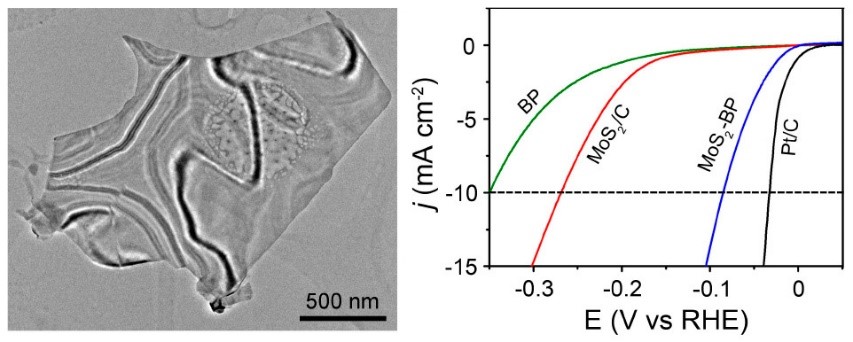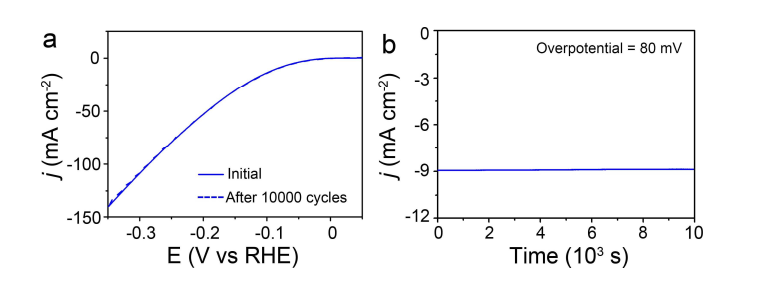Professor ZENG Jie’s group has created a cheap, efficient and stable catalyst for water electrolysis hydrogen production. Through regulating interfaces, they devised a kind of Molybdenmun disulfide-black phosphorus (MoS2-BP) hybrid nanosheets catalyst, which shows high activity and high stability during hydrogen evolution reaction (HER). The extensive use of fossil fuels leads to the environmental pollutions in our living conditions. Thus, hydrogen serves as a future energy resource to reduce the dependence on petroleum by virtue of the highest mass energy density and renewability. Electrochemical water splitting represents one of the most convenient and promising approaches to hydrogen generation. Currently, commercial electrocatalysts toward HER are typically composed of noble metals, especially Pt and Pd. The scarcity and high cost of noble-metal catalysts have hampered the large-scale deployment of HER technologies. Therefore, increasing attention has been paid to applying nonprecious metal catalysts for HER.

Figure 1. TEM image of a typical MoS2–BP nanosheet and its high performance
(Image by ZENG Jie)
To solve these problems, researchers used the interface control technology to design and construct a cheap and efficient MoS2-BP hybrid nanosheet catalyst. In MoS2-BP nanosheets, effective electron transfer from BP to MoS2 was achieved because of the higher Fermi level of BP than that of MoS2. The electron rich MoS2 part of the nanosheets served as highly active catalytic center. And the as-synthesized MoS2-BP nanosheets exhibited remarkable HER activity with an overpotential of 85mV at 10 mA cm-2, close to that of commercial Pd-C catalyst. Moreover, the catalytic activity of MoS2-BP nanosheets was retained in the current after 10,000 cycles and after 104 seconds (3 hours) , suggesting the potential use of the MoS2-BP catalysts over a long time in an electrochemical process. The success of engineering electronic properties by forming MoS2-BP heterostructures presents a straightforward strategy to design hybrid electrocatalysts.

Figure 2. (a) LSV curves of MoS2-BP nanosheets after 10,000 cycles. (b) Plot of current density (j) versus time for MoS2-BP nanosheets at a constant overpotential of 80 mV
The results were published at Nano Lett. titled as "Molybdenum disulfide-black phosphorus hybrid nanosheets as a superior catalyst for electrochemical hydrogen evolution". The co-first authors are doctoral candidate HE Rong and master degree candidate HUA Jian.
This work was supported by Key Research Program of Frontier Science of CAS, Strategic Priority Research Program B of the CAS, NSFC, Collaborative Innovation Center of Suzhou Nano Science and Technology, MOST of China, and Fundamental Research Funds for the Central Universities.
Contact
Prof. ZENG Jie
zengj@ustc.edu.cn
(DENG Weiting, USTC News Center, Hefei National Laboratory for Physical Science at the Microscale)